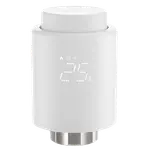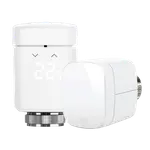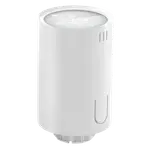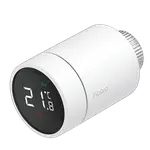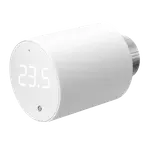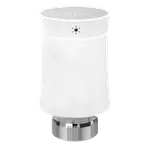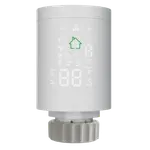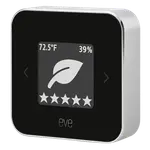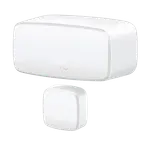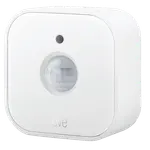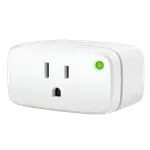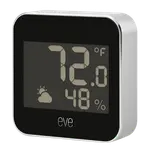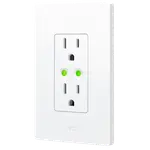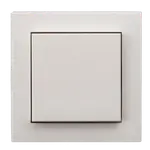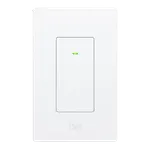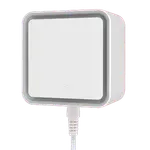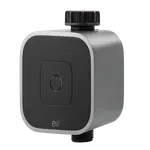
Summary
Size & Materials: 130g / 4.58oz, 54 x 67 x 85 mm
Connectivity: Bluetooth, Thread Protocol (Thread Border Router required)
Integrations: Google Home, Alexa, Apple HomeKit, Samsung SmartThings, Home Assistant, Matter
Display: LED
Sensors: Temperature
Scheduling: Manually
Features: Geofencing (Hub required), Frost Protection, Child Lock, Display Temperature
Price History
Loading price history...
| Brand | Eve |
|---|---|
| Headquarters | |
| Website | https://www.evehome.com |
| @meeteve |
Size & Materials
Length x Width x Height
- Length: the longest side of the device
- Width: the shorter side of the device
- Height: the vertical dimension of the device
54 x 67 x 85 mm
The physical weight of the device, typically measured in grams (g) or ounces (oz).
Weight can be important for installation considerations, especially for wall-mounted or battery-powered devices.
130g / 4.58oz
Power
Battery-powered sensors typically use standard batteries like AA, AAA, or button-cell batteries (CR2032, CR123A), which are easy to replace and widely available.
2x AA
Sensors that connect via Wi-Fi tend to consume more power due to the constant need to maintain a connection with the network, meaning more frequent battery replacements.
Zigbee, Z-Wave, and Thread Sensors are designed for low-power devices, allowing sensors to last much longer on battery power, often up to 3-5 years before needing a battery change.
Bluetooth Low Energy (BLE) sensors have moderate power consumption, offering a reasonable battery life depending on usage.
?
Connectivity
Range: The 2.4 GHz band offers a longer range, meaning it can cover larger areas and penetrate solid objects like walls more effectively than 5 GHz.
Speed: Generally, 2.4 GHz provides slower speeds compared to 5 GHz due to a lower maximum data rate.
Interference: More prone to interference since many other devices (like cordless phones, microwaves, and Bluetooth devices) operate on the 2.4 GHz frequency, leading to potential congestion and slower network performance.
NO
Range: Offers a shorter range compared to 2.4 GHz and may have difficulty penetrating walls and other obstacles.
Speed: Typically provides faster speeds and higher data rates due to more available bandwidth.
Interference: Less prone to interference as fewer devices operate on this frequency, leading to a more stable connection.
NO
Bluetooth is a wireless communication technology used for exchanging data over short distances.
Bluetooth enables devices to communicate wirelessly within a short range, typically up to 10 meters (about 33 feet) for most consumer devices.
YES
Zigbee is a wireless communication protocol designed for low-power, short-range applications, commonly used in smart home devices, industrial automation, and other areas requiring reliable, low-data rate communication. It features low power consumption, making it ideal for battery-operated devices, and supports short-range communication, typically up to 100 meters. Zigbee employs mesh networking, allowing devices to relay data through each other to extend range and improve reliability. It supports data rates up to 250 kbps, suitable for small data packets, and ensures interoperability among devices from different manufacturers if they conform to Zigbee standards. Security is robust, with AES-128 encryption for data protection.
Z-Wave is known for its low power consumption, making it ideal for battery-powered devices. It supports a mesh networking topology, allowing devices to communicate with each other directly or through intermediary nodes, thus extending the overall network range and enhancing reliability. The protocol supports data rates of up to 100 kbps, suitable for transmitting control commands and sensor data.
NO
Zigbee is a wireless communication protocol designed for low-power, short-range applications, commonly used in smart home devices, industrial automation, and other areas requiring reliable, low-data rate communication. It features low power consumption, making it ideal for battery-operated devices, and supports short-range communication, typically up to 100 meters. Zigbee employs mesh networking, allowing devices to relay data through each other to extend range and improve reliability. It supports data rates up to 250 kbps, suitable for small data packets, and ensures interoperability among devices from different manufacturers if they conform to Zigbee standards. Security is robust, with AES-128 encryption for data protection.
Zigbee devices need a Zigbee-compatible hub to connect and communicate with other devices in your smart home setup.
NO
Thread is a wireless communication protocol designed specifically for Internet of Things (IoT) devices, providing secure, reliable, and scalable networking. Unlike some other protocols, Thread is IP-based, which means it can seamlessly integrate with existing internet infrastructure. It operates in the 2.4 GHz frequency band and uses mesh networking to enhance reliability and extend range by allowing devices to relay data through each other.
Thread is optimized for low power consumption, making it suitable for battery-operated devices. It supports low-latency communication, which is crucial for real-time applications like home automation and security systems. The protocol ensures high security with AES-128 encryption and end-to-end security at the network layer. Thread also supports over-the-air updates, ensuring devices can stay up to date with the latest features and security patches.
Thread-enabled devices require a Thread Border Router (such as certain smart home hubs or routers) to connect to your home network and other Thread devices.
Thread Border Router required
Integrations
Google Home serves as a central hub for a variety of smart devices, including lights, radiator valves, cameras, and speakers. It leverages Google Assistant for voice control, enabling users to manage their smart home with simple commands.
YES
Amazon Alexa is one of the most widely used smart home systems, known for its compatibility with a vast array of devices. Users can control everything from smart lights to appliances using voice commands through Echo devices.
YES
Apple HomeKit is designed for users in the Apple ecosystem, providing a seamless way to control compatible smart devices through iOS devices using the Home app or Siri. It emphasizes security and user privacy.
YES
SmartThings is a flexible platform that connects a wide range of devices from different brands, offering a unified interface for control. It supports various communication protocols, allowing for extensive device compatibility.
YES
Home Assistant is an open-source platform that allows for extensive customization and integration of a wide variety of smart devices. It supports a multitude of protocols and brands, making it ideal for tech-savvy users.
YES
IFTTT (If This Then That) is a web-based service that allows users to create simple automation sequences, known as applets, which enable different devices, services, and applications to work together seamlessly. It connects a wide range of products and services, facilitating interoperability and enhancing functionality.
NO
Matter is a unified, open-source connectivity protocol designed to standardize and simplify communication between smart home devices from different manufacturers. Developed by the Connectivity Standards Alliance (formerly the Zigbee Alliance), Matter aims to improve interoperability, security, and reliability across various smart home ecosystems.
Matter operates over existing networking technologies, including Ethernet, Wi-Fi, and Thread, providing flexibility in device connectivity. Its IP-based nature allows seamless integration with existing internet infrastructure and cloud services. Matter uses a mesh networking topology, particularly when operating over Thread, to enhance range and reliability by allowing devices to relay data through each other.
Security is a cornerstone of Matter, with end-to-end encryption and secure device onboarding processes ensuring robust protection for data and privacy. Matter also supports over-the-air updates, allowing devices to stay current with the latest features and security enhancements.
YES
Display
Indicates whether the device has a built-in display screen.
A screen can show real-time information, settings, and status without needing to check a mobile app.
YES
The type of display technology used, such as LCD, OLED, E-ink, or LED.
Different screen types offer varying levels of visibility, power consumption, and image quality.
LED
The diagonal measurement of the display screen, typically in inches.
Larger screens are easier to read from a distance but may consume more power.
?
Sensors
Measures ambient temperature in the surrounding environment.
Temperature monitoring helps maintain comfortable conditions and can trigger heating/cooling automations.
YES
Measures relative humidity levels in the air.
Humidity monitoring helps prevent mold growth and maintains optimal indoor air quality.
NO
Scheduling
Manual control and scheduling of temperature settings.
Manual control allows you to set specific temperatures and schedules according to your preferences.
YES
Automatic temperature adjustment based on occupancy and learning algorithms.
Automatic control learns your preferences and adjusts heating to optimize comfort and energy efficiency.
NO
AI-powered recommendations for optimal heating schedules and settings.
Smart suggestions help you save energy while maintaining comfort by recommending efficient heating patterns.
NO
Features
Support for additional temperature sensors in other rooms.
External sensors provide more accurate room temperature readings and enable multi-zone climate control.
NO
Location-based automation that adjusts settings when you leave or return home.
Geofencing automatically reduces heating when you're away and warms up the home before you return.
Hub required
Don't live life to a fixed schedule? Have Eve Thermo reduce the temperature when everyone’s left for the day. Then as soon as someone returns home, have Eve Thermo raise the temperature automatically
To control your heating based on location, you need a home hub (HomePod mini, HomePod or Apple TV).
Automatic heating to prevent pipes from freezing in cold weather.
Frost protection maintains minimum temperatures to prevent costly freeze damage to plumbing systems.
YES
Safety feature that prevents accidental changes to settings.
Child lock prevents children from adjusting important settings and helps maintain consistent operation.
YES
Shows current temperature readings on the device display.
Temperature display provides immediate visual feedback of current conditions without checking apps.
YES
The ability to create automated actions based on sensor readings or schedules.
Automations can trigger other smart devices, send notifications, or adjust settings without manual intervention.
YES


![Bosch Smart radiator thermostat II [+M]](/img/item-types/radiator-valves/bosch-smart-radiator-thermostat-2-thumb.webp)
